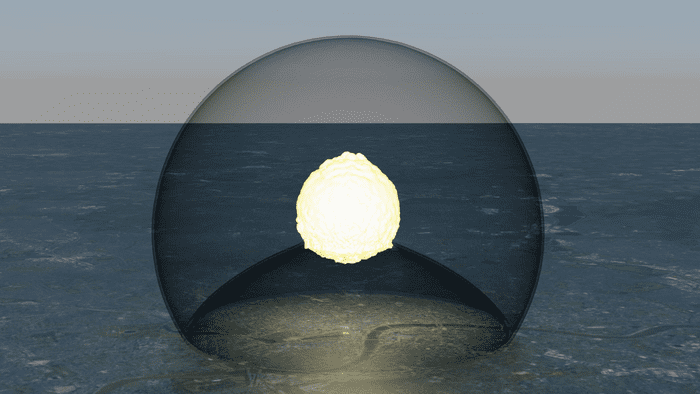
The end of the Cold War brought about a new world order, one in which it seemed like the specter of nuclear war was finally kept at bay. But nuclear weapons never went away and nuclear nations like the US and Russia still have enough stockpiles of these weapons of mass destruction to pulverize the entire surface of the planet many times over. Most recently, the war in Ukraine and Russian President Vladimir Putin’s saber-rattling have renewed global tensions and brought the looming threat of nuclear war back to the forefront.
These tensions have also renewed scientists’ interest in the effects of nuclear weapons. While radiation and the initial fireball following a nuclear explosion are relatively well studied, there are still gaps in our knowledge concerning the effects that the enormous blast wave generated by a nuclear detonation can have on people sheltering at a significant relative distance from the epicenter of the explosion.
The official U.S. government advice in the event that you happen to see a mushroom cloud is to “take shelter in the nearest and most protective building.” That’s still sound advice, but new research shows that even indoors and several kilometers away from the site of detonation, a nuclear blast wave can be gut-wrenching.
Few places to hide from a nuclear blast
In a new study, researchers at the University of Nicosia simulated the detonation of an intercontinental ballistic missile over a city in order to study what would happen to people sheltering indoors inside a concrete building. Using advanced computer modeling, the researchers found that the pressure wave generated by a typical modern nuclear warhead is powerful enough to push a person off their feet and slam them against walls even at a distance of a few kilometers away from the epicenter of the blast zone.
“Furthermore, there are no studies on the impact of the wind gust from a nuclear blast wave indoors on buildings far enough to withstand it, for example, reinforced concrete buildings in the medium destruction zone (MDZ). The findings suggest that the airspeed behind the blast wave induces significant forces on humans indoors. The most potent forces are experienced for a short period of up to half a second. The airspeed behind the blast wave accelerates indoors to even higher velocities. This stems from the expansion of the shock waves entering the space through an opening such as a window. Furthermore, channeling effects can further accelerate the air in the corridors,” lead author Professor Dimitris Drikakis of the University of Nicosia told ZME Science.

According to the simulation, a person hiding for cover inside a concrete building 5-6 kilometers away from the site of detonation will experience several G-forces of body mass acceleration when hit by air pushed by the blast wave. In some extreme situations, the acceleration could exceed 140 G’s. Experiencing such massive amounts of acceleration even for a fraction of a second can shatter bones and break a person’s spine with ease.
The most dangerous indoor locations are the windows, corridors, and doors, where the associated blast wave forces are strongest. In contrast, the corners of the room experience the least amount of force, making them the ideal locations to seek shelter indoors, even if the nearest corner faces the blast. You have to think fast though since it takes just a few seconds for the blast wave to travel a few kilometers.
But the blast wave is just one of the many problems you need to worry about. In addition, there are damaged power and gas lines, fires, and of course radiation and fallout that you have to worry about.
“The most destructive effects of a nuclear weapon come from the immense explosion and radiation. The blast wave can level buildings and cause widespread destruction over a large area, while the intense heat can cause fires that can burn for days and cause further damage. The radiation emitted by a nuclear weapon can cause both immediate and long-term health effects, including cancer and genetic mutations,” Drikakis said.
Nuclear war might seem like an unimaginable possibility but for Drikakis, one of the most surreal moments was working on these fluid dynamics simulations while Putin and his Kremlin pundits were more or less overtly putting the nuclear option on the table when discussing the outcome of the war in Ukraine.
“It was interesting to see all the media reporting on the risk of nuclear war while we were carrying out the simulations, engineering, and physics analysis in the background,” the researcher said.
Despite its weaker military and economy, Ukraine has been able to defend itself and, at some points, counterattack Russia thanks to the bravery of its soldiers and massive Western support. Because of the unprecedented trajectory of the war, Russia finds itself in a dire situation — exactly the conditions in which one would consider using weapons of mass destruction. Putin has also declared captured and illegally annexed Ukraine territory across the Donbas and Kherson region under Russia’s “nuclear umbrella,” meaning the Russian government sees itself entitled to defend the area if it is attacked, relying on nuclear deterrence to caution external forces from intervening.
“We should raise awareness among the community [politicians, scientists, and citizens] that a nuclear war is an unthinkable scenario but still possible. Thus, we must all intensify our efforts to prevent this from happening,” Drikakis said.
The new findings appeared in the journal Physics of Fluids.






